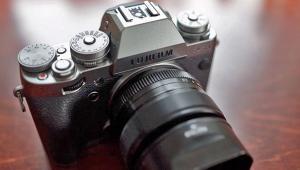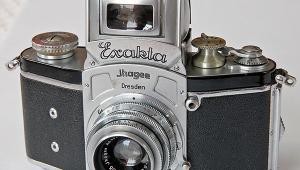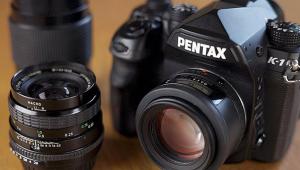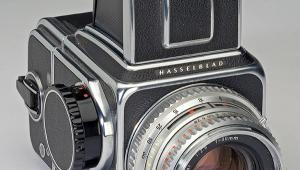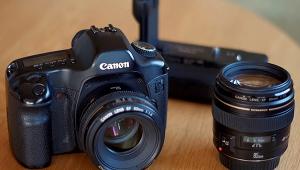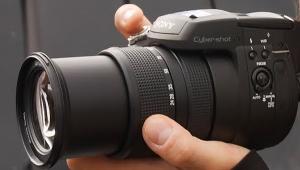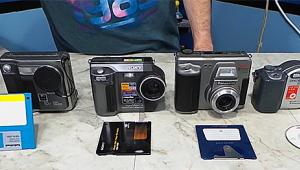The Soho Reflex
An SLR With Swings And Tilts
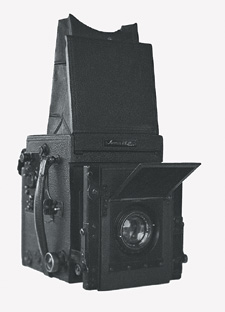 Imagine a hand holdable single lens reflex camera that has front movements similar to a view camera to allow control of plane of focus. If you think that's a pretty modern concept, you are only about 100 years too late. The Soho Reflex camera, made from 1905 up to the 1940s, was just such an item. Manufactured by Kershaw of Leeds, England, and marketed under several different names (Kershaw, Marion, Ross, Soho, London Stereoscopic, among others) it is most often found in the quarter-plate size (31/4x41/4"), but smaller and larger sizes do exist. It has a vertical-running focal plane shutter that could be set for T or speeds from 1/16 to 1/800 per second and a patented mechanism that dampened mirror movement to reduce vibration as the shutter was released.
Imagine a hand holdable single lens reflex camera that has front movements similar to a view camera to allow control of plane of focus. If you think that's a pretty modern concept, you are only about 100 years too late. The Soho Reflex camera, made from 1905 up to the 1940s, was just such an item. Manufactured by Kershaw of Leeds, England, and marketed under several different names (Kershaw, Marion, Ross, Soho, London Stereoscopic, among others) it is most often found in the quarter-plate size (31/4x41/4"), but smaller and larger sizes do exist. It has a vertical-running focal plane shutter that could be set for T or speeds from 1/16 to 1/800 per second and a patented mechanism that dampened mirror movement to reduce vibration as the shutter was released.
The Soho Reflex was an upscale photographic instrument during its time, built with craftsmanship during the zenith of the English camera industry. Most commonly encountered today is the black leather-covered standard model obtainable for a couple hundred dollars, but a stained wood tropical version commands much interest (and big money) from collectors.
Not all Soho Reflexes have front movements. My camera (illustrated here) has front rise, tilt, and swings, but others that I've seen have no front movements, or just front rise, or front rise and tilt only. Front standard rise (+5/16") and tilt (±4Þ) are easy to recognize, but what about that swing? Ingeniously, on cameras so equipped, the focusing knob on the right front of the camera body pulls out. Twisting the pulled-out knob forward moves the right focusing track forward and twisting the knob backward moves the right focusing track rearward. Since the left track remains motionless, the result is left or right swing of the front standard of up to ±15Þ!
Now, you've got to admit that this is pretty cool, especially for a 100-year-old design. Quite a lot has been written about this camera, especially the tropical model, but I am not aware of any description of the front swings outside of the instruction manual. I wonder how many Soho Reflex owners might be surprised to discover their camera has factory built-in front swing! According to the instruction manual (mine dates to the 1920s) the front swing mechanism was also available as a retrofit option to previously purchased cameras, but I hazard a guess that present owners are out of luck.
I purchased my camera off eBay in remarkably good cosmetic condition, but with a tarnished mirror and decayed shutter curtains. I replaced the mirror with a new one from Edmund Scientific for a brighter focusing image. Copying the old curtains with shutter cloth and tape (ribbon) from Fargo Industries and a few hours labor later I was ready to shoot.
My camera has the older shutter mechanism and due to the age of the springs I really only get a couple of usable speeds (~1/20 and 1/100 per second). An improved model (circa 1914) is recognized by a large round shutter winding dial on the right-hand side of the camera body and probably offers better function and reliability. On both versions, however, the shutter is non-capping, which means that after a picture is taken the mirror must be lowered and/or dark slide returned to the film holder to prevent the film from being exposed when the shutter is wound.
My camera, marked No.22, came with a 150mm f/4.5 Ross London Zeiss Tessar, which now sparkles after I disassembled it to clean off a near-century of haze. Also included was a bag magazine with a Graflex-like slot down the side but with a unique cutout for quick insertion and removal. Size 120 rollfilm holders made by Rada and Rollex were also available in adapters to fit the Soho Reflex back, which revolves to allow vertical or horizontal pictures.
There are other SLR cameras capable of front movements. The Graflex 5x7 Home Portrait camera (circa 1912-1940) has front standard tilt, plus rise and fall, and the R.B. Auto Graflex (circa 1909-1941) has front rise. In the 1960s Arca Swiss made a metal reflex camera that had front movements when mounted on a monorail and the Rollei SL66 had a drop front which allowed some control of the plane of focus. Presently available new are the Fuji GX-680 with full front standard movements, the Mamiya RZ67 Tilt/Shift adapter and the Horseman View Camera Converter for 35mm and medium format cameras (usable with long focus lenses only). So, this is an idea which has some merit as it obviously will not go away.
Mounted on a tripod the Soho Reflex is quite functional and the Tessar takes very nice pictures, although any lens that will fit the smallish 3" lensboard could be used. The major drawback is the lack of wide angle lenses; the shortest practical lens is ~5" and bellows extend to allow a total flange to film plane distance of ~101/2". I purchased my camera for vintage picture-taking fun. I am not a collector per se, but using the largish Soho Reflex handheld for any length of time reminds one of the virtues of a Nikon F. Perhaps the most fun is to realize that even in the digital age everything old is new again.
Resources
A Century of Cameras, Eaton S. Lothrop, page 172, Morgan & Morgan, 1973.
An Age of Cameras, Edward Holmes, pgs. 59-62, Fountain Press, 1974.
Jason Schneider on Camera Collecting, page 91, Wallace Homestead, 1978.
"Using a Quarter Plate Soho Reflex," Tom Holliday, Photographica World 73:22-24, 1995.
Collecting and Using Classic SLRs, Ivor Mantanle, pgs. 243-245, Thames & Hudson, 1996.
The Soho Reflex Camera, Soho Ltd., London, undated.
Edmund Scientific, www.edmundoptics.com, search "mirrors."
Fargo Enterprises, www.micro-tools.com
